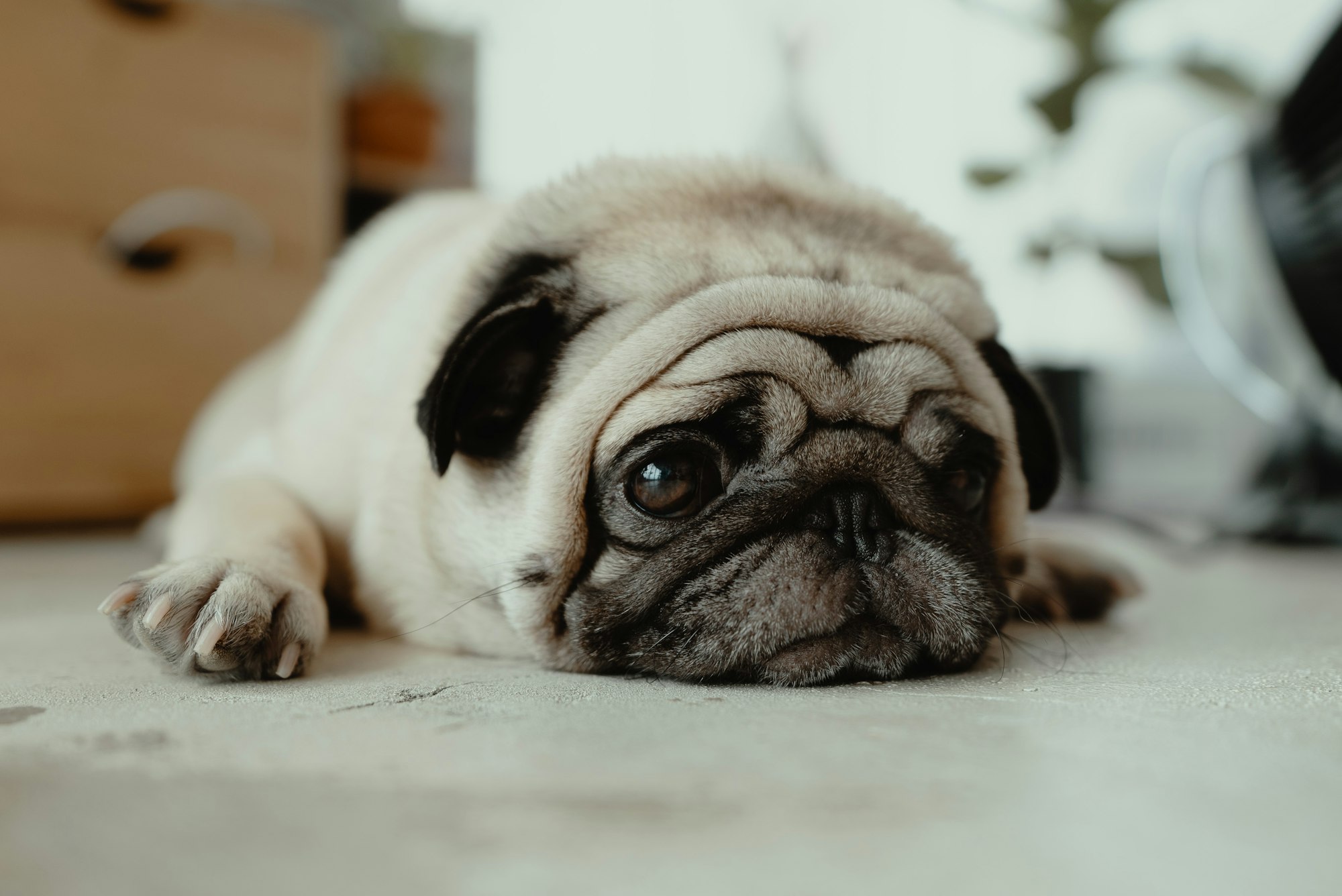Pug skull anatomy is a fascinating topic.
This breed, adored for its distinctive features and amiable personality, has a unique skull structure that not only contributes to its appearance but also has significant implications for its health.
As we delve into the specifics of pug skull anatomy, we'll cover key topics including brachycephalic syndrome, pug health concerns, and the implications of their unique cranial features.
The Structure of a Pug's Skull
Pugs belong to a group of dogs known as brachycephalic breeds.
This term originates from the Greek words for "short" and "head".
And that's exactly what distinguishes these dogs - a noticeably compact skull.
The face of a pug is characterized by a short snout and a domed head.
This gives them their distinctive "squished" face look, which many find endearing.
While this makes the breed visually unique, it's the result of a specific genetic trait that affects their skull development and results in a shortened upper jaw.
Health Implications of Brachycephalic Syndrome
But there's more to the pug's facial structure than just its appearance.
Brachycephalic syndrome is a condition commonly associated with breeds like pugs, where their compact skull anatomy leads to certain health challenges.
Pugs often experience breathing difficulties due to their shortened snouts.
They may also be prone to eye problems due to their prominent eyes, another characteristic of their unique skull structure.
Distinctive Pug Features and Their Health Concerns
Understanding the pug skull anatomy is essential when caring for a pug, as it alerts owners to potential health concerns.
For instance, a common problem among pugs is tooth decay.
This is because their shortened upper jaw often doesn't provide enough space for their teeth, leading to overcrowding and an increased likelihood of dental issues.
That's why it's crucial to groom a dog of this breed regularly, paying special attention to dental care.
On the other hand, their squashed face structure can make them prone to excessive scratching and licking due to the discomfort caused by skin folds.
Investing in a scratch board can help provide relief and prevent potential skin issues.
The Role of Positive Reinforcement in Managing Pug Health
Despite these challenges, many pug owners find that the breed's loving personality outweighs the health issues.
Positive reinforcement plays a significant role here.
Owners can train their pugs to tolerate regular grooming routines, teeth cleaning, and other necessary health maintenance tasks by associating them with rewards.
This makes managing potential health issues related to the pug skull anatomy more manageable and less stressful for both the dog and the owner.
The Comparison of Pug Skull Anatomy with Other Breeds
Compared to other breeds, the pug's skull is noticeably different.
Most breeds have a longer snout and less prominent eyes.
This allows for better breathing and fewer health problems associated with brachycephaly.
One way to appreciate the uniqueness of pug skull anatomy is through dog sports.
While pugs may not excel in traditional dog sports due to their unique anatomy, they often shine in sports tailored to their abilities, like nosework or obedience.
This proves that despite their distinctive skull structure, pugs can still lead a fulfilling and active life.
The Genetics Behind the Pug's Unique Skull Structure
The distinctive skull structure of pugs is a result of selective breeding.
Breeders, over many generations, have selected for traits that give pugs their distinctive appearance.
This means that the genes responsible for the shortened snout and domed head have been intentionally passed on through the generations.
While this has resulted in the cute and lovable face we all adore, it's also given rise to the health concerns associated with brachycephaly.

The Pug's Peculiar Facial Expressions
Another captivating aspect of the pug skull anatomy is the way it contributes to their unique facial expressions.
Those big, round eyes and the wrinkles on their forehead are not just cute; they also give pugs an expressive face.
Pugs can appear to show a wide range of emotions, from curiosity and excitement to confusion and even sadness.
Their expressive faces are part of what makes them so endearing to humans.
It's almost as if they have their own language, and it all starts with their unique skull structure.
The Role of a Vet in Managing Pug Health
Given the potential health issues related to pug skull anatomy, having a trusted vet is essential for pug owners.
The vet can provide routine check-ups, help manage any issues that arise, and guide the owner in preventing potential health problems.
For instance, they can provide advice on how to groom a dog of this breed to reduce the chance of skin issues in the folds of their skin.
Regular dental check-ups can also prevent tooth decay, a common issue due to the overcrowded teeth resulting from the pug's distinctive skull structure.
Pugs and Socialization
The pug's amiable personality makes them great companions.
But their unique skull structure can sometimes impact their social interactions with other dogs.
Due to their shortened snouts and breathing difficulties, pugs might not be able to engage in vigorous play as other breeds do.
However, this doesn't mean they can't enjoy socializing.
They can still have fun and engage with other dogs, albeit at a slower pace.
Moreover, their friendly nature and expressive faces often make them a hit at the dog park!
The Pug's Distinctive Snore
Pugs are also known for their distinctive snore, another aspect related to their unique skull anatomy.
While this might be endearing to some, it's another manifestation of the breathing difficulties associated with brachycephalic breeds.
Owners need to monitor their pugs for any signs of breathing distress, especially during sleep or after physical activity.
Training and Pug Skull Anatomy
Training a pug, just like any other dog breed, requires patience, consistency, and an understanding of their unique needs.

Because of their skull structure, pugs might face certain challenges that other breeds don't.
For instance, they can become easily winded or overheated due to their breathing difficulties.
Training sessions should, therefore, be short and should not be too physically demanding.
Also, due to the potential for tooth decay, selecting suitable chew toys or training treats becomes more crucial.
Remember, your aim is to provide positive reinforcement without compromising your pug's dental health.
Pugs: Indoor or Outdoor Dogs?
Given their distinctive skull anatomy and the health concerns associated with it, pugs are generally considered indoor dogs.
Their breathing difficulties can become exacerbated in hot or humid conditions, making it important for them to have a cool, comfortable place to retreat.
That's not to say that pugs should not get outdoor exercise.
They should, but always under close supervision and with plenty of water available.
Dog sports, for instance, can provide a fun and safe environment for pugs to get the physical activity they need.
Pugs and Dog Apparel
Pugs, with their distinct skull structure and potential breathing issues, often struggle to regulate their body temperature.
This means that pugs might need extra assistance staying warm during the colder months.
Dog apparel, such as sweaters or coats, can help keep your pug comfortable in cold weather.
On the other hand, during the summer, it's crucial to provide a cool environment and plenty of water to prevent overheating.
Adopting a Pug: A Rewarding Experience
Adopting a pug can be a rewarding experience, filled with love, laughter, and plenty of snuggles.
Their distinctive skull structure, expressive faces, and charming personalities make them a favorite among dog lovers.
However, understanding pug skull anatomy and the health implications that come with it is essential before deciding to adopt.
Potential pug owners must be prepared to address the unique health concerns of this breed, from regular grooming to managing potential tooth decay and breathing difficulties.
It might seem daunting, but the reward is a loyal, loving, and utterly adorable companion that will bring joy and love into your home.

Training a Pug with the Help of Fi Dog Collars
Training a pug, as mentioned, requires an understanding of their unique needs.
This is where tools like Fi dog collars come in.
Fi dog collars are smart collars that can help monitor your pug's activity levels.
Given a pug's unique skull anatomy and potential for breathing issues, keeping an eye on their activity can be essential in preventing overexertion.
With its real-time tracking, you can ensure that your pug's training sessions and playtimes are in line with their abilities, ensuring they stay healthy and happy.
Pugs and Outdoor Safety with Fi Dog Collars
While pugs are generally considered indoor dogs due to their skull anatomy, they do need their outdoor time for exercise and stimulation.
This is another scenario where Fi dog collars come to the rescue.
With its GPS tracking feature, you can have peace of mind knowing exactly where your pug is, making outdoor activities safer.
Whether it's a leisurely walk in the park or a stimulating session of nosework in a controlled environment, the Fi collar helps ensure that your pug is safe and secure.
Fi Dog Collars and Temperature Alerts
As we've discussed, pugs can struggle with body temperature regulation due to their distinctive skull structure.
Fi dog collars can assist in this area too.
They can send alerts when the environment gets too hot or cold, helping you keep your pug comfortable and preventing temperature-related health issues.
So whether it's ensuring they have a sweater on in the cold or are staying cool in the heat, Fi dog collars can help you stay on top of your pug's needs.
Adopting a Pug and the Role of Fi Dog Collars
If you're considering adopting a pug, equipping yourself with tools like Fi dog collars can greatly assist in caring for this unique breed.
With features designed to monitor your dog's location and activity, and temperature alerts to ensure their comfort, the Fi collar is an excellent tool for any pug owner.
It's another step in understanding and providing for the specific needs of pugs, ensuring they lead a happy, healthy life.
Final Thoughts
The distinct skull structure of pugs, brought about by selective breeding, results in their charmingly expressive faces and signature snore. However, it also brings unique health challenges. From potential breathing difficulties to dental issues, understanding pug skull anatomy is crucial for any pug owner.
Implementing strategies like effective grooming to prevent skin issues, careful training regimens, and providing a comfortable indoor environment can mitigate these health risks. Fi dog collars can be an excellent tool to aid in these endeavors.
They provide real-time activity tracking, GPS location services, and temperature alerts that can ensure a safer and healthier lifestyle for your pug. By embracing their distinctive features and employing the right care and modern technology, you can ensure a rewarding and loving relationship with your pug.